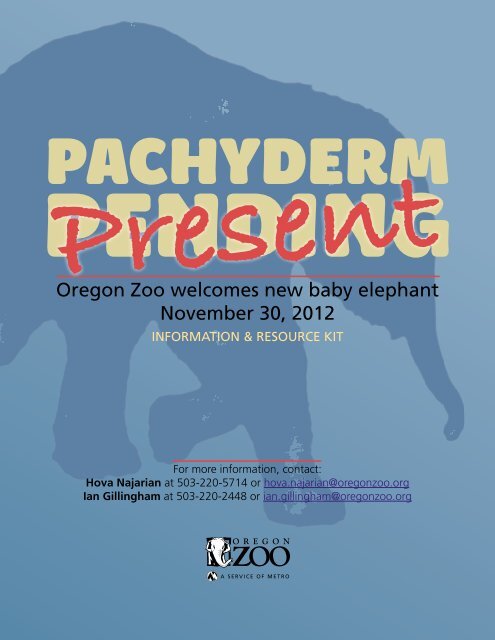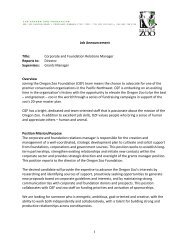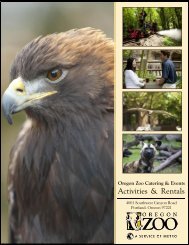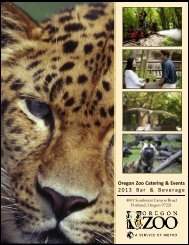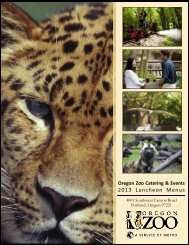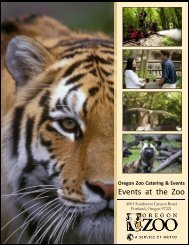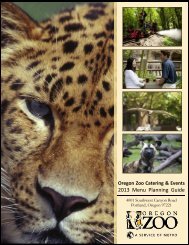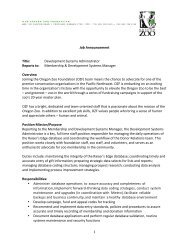You also want an ePaper? Increase the reach of your titles
YUMPU automatically turns print PDFs into web optimized ePapers that Google loves.
Pachyderm<br />
Present<br />
Pending<br />
<strong>Oregon</strong> <strong>Zoo</strong> welcomes new <strong>baby</strong> elephant<br />
November 30, 2012<br />
Information & Resource KiT<br />
For more information, contact:<br />
Hova Najarian at 503-220-5714 or hova.najarian@oregonzoo.org<br />
Ian Gillingham at 503-220-2448 or ian.gillingham@oregonzoo.org
inside<br />
It’s a girl! . . . . . . . . . . . . . . . . . . . . . . . . . . . . . . . . . 3<br />
A new elephant <strong>baby</strong>, a better elephant home . . . . . 5<br />
50 years of elephant births . . . . . . . . . . . . . . . . . . . . 6<br />
<strong>Elephant</strong> babies . . . . . . . . . . . . . . . . . . . . . . . . . . . . 8<br />
<strong>Zoo</strong> family . . . . . . . . . . . . . . . . . . . . . . . . . . . . . . . . 9<br />
Getting to know Rose-Tu . . . . . . . . . . . . . . . . . . . . 10<br />
Getting to know Samudra . . . . . . . . . . . . . . . . . . . 12<br />
Getting to know the zoo elephants . . . . . . . . . . . . 13<br />
<strong>Elephant</strong> Lands: The new elephant habitat . . . . . . . 15<br />
Conservation in North America . . . . . . . . . . . . . . . 17<br />
Conservation in range countries . . . . . . . . . . . . . . . 18<br />
Asian elephant fact sheet . . . . . . . . . . . . . . . . . . . . 19<br />
See more . . . . . . . . . . . . . . . . . . . . . . . . . . . . . . . . 20<br />
Contact<br />
For more information or to schedule an interview<br />
with <strong>Oregon</strong> <strong>Zoo</strong> staff, please contact:<br />
Hova Najarian<br />
Media and Public Relations Officer<br />
503-220-5714<br />
hova.najarian@oregonzoo.org<br />
Ian Gillingham<br />
Assistant Media and Public Relations Officer<br />
503-220-2448<br />
ian.gillingham@oregonzoo.org<br />
About the <strong>Oregon</strong> <strong>Zoo</strong><br />
The zoo is a service of Metro and is dedicated to its<br />
mission of inspiring the community to create a better<br />
future for wildlife. Committed to conservation, the<br />
zoo is currently working to save endangered California<br />
condors, <strong>Oregon</strong> silverspot and Taylor’s checkerspot<br />
butterflies, western pond turtles, <strong>Oregon</strong> spotted frogs<br />
and Kincaid’s lupine. Other projects include studies on<br />
black rhinos, Asian elephants, polar bears and bats.<br />
The zoo relies in part on community support through<br />
donations to the <strong>Oregon</strong> <strong>Zoo</strong> Foundation to undertake<br />
these and many other animal welfare, education and<br />
sustainability programs. For hours and rates, visit www.<br />
oregonzoo.org or call 503-226-1561.<br />
O R E G O N Z O O P A C h y d e r m P r e s e n t 2 0 1 2 M E D I A K I T<br />
2
OREGON ZOO NEWS<br />
For im<strong>media</strong>te release | November 30, 2012<br />
IT’S A GIRL! OREGON ZOO ELEPHANT ROSE-TU DELIVERS 2nd CALF<br />
Newest member of zoo’s elephant herd is born at 2:17 a.m. on Nov. 30<br />
PORTLAND, Ore. — The long wait is over. Rose-Tu, an<br />
18-year-old Asian elephant, gave birth to a 300-pound<br />
female calf at the <strong>Oregon</strong> <strong>Zoo</strong> at 2:17 a.m. on Friday,<br />
Nov. 30.<br />
“We’re all delighted at the arrival of Rose-Tu’s new<br />
calf,” said Kim Smith, <strong>Oregon</strong> <strong>Zoo</strong> director. “The calf<br />
is beautiful, healthy, tall and very vigorous. As soon as<br />
she hit the ground — before she was even out of the<br />
amniotic sac — she was wiggling. And she’s vocalizing<br />
loudly. The first time we heard her, the sound was so<br />
deep and loud that we thought it was Shine. She’s<br />
definitely got a great set of pipes, and it looks like she’s<br />
going to be a real pistol.”<br />
Smith said Rose-Tu is doing well after more than 30<br />
hours of labor and more than 21 months of pregnancy,<br />
thanks to a daily exercise regimen that has kept her<br />
in top shape. <strong>Zoo</strong> staff and much of the surrounding<br />
community had been on <strong>baby</strong> watch since Nov. 25,<br />
when Rose-Tu’s progesterone levels dropped to near<br />
zero, indicating labor should begin soon. Rose entered<br />
early labor in the afternoon of Nov. 28 and began<br />
showing signs of active labor around 12 a.m. today.<br />
Im<strong>media</strong>tely following the birth, the zoo’s animal-care<br />
staff took the calf aside to clean it and perform a quick<br />
veterinary checkup, and they are now working to<br />
reintroduce the mother and calf.<br />
“Rose is doing considerably better this time around,”<br />
Smith said. “When Samudra was born, it was four<br />
days before she would even let him come near her, so<br />
we’re much farther along this time. We’re starting to<br />
see motherly behavior from Rose, and the calf is already<br />
nursing a bit. These are great signs that the mothercalf<br />
bond will be a strong one. Our animal-care staff<br />
is working hard to help the two along, and things are<br />
progressing every minute.”<br />
“Our keepers and veterinary staff have put an<br />
extraordinary amount of work and care into helping<br />
Rose-Tu bring her <strong>baby</strong> into the world,” Smith added.<br />
“The time spent training and preparing has paid off, and<br />
the outcome is exactly the one we’d hoped for: Rose is<br />
safe and healthy, and she has a beautiful newborn calf.<br />
Now that the <strong>baby</strong>’s here, we’re all excited to watch her<br />
bond with Rose-Tu and take her place in the herd.”<br />
It might still take a little time before the new <strong>baby</strong> is<br />
ready for visitors though.<br />
“The main thing determining that will be the strength<br />
of the bond between Rose-Tu<br />
and the calf,” said Bob Lee,<br />
the zoo’s elephant curator.<br />
“Rose should allow the calf<br />
to nurse regularly, sleep, play<br />
and generally act like a calf<br />
without trying to stop it and<br />
control its movements. Then<br />
we’ll determine whether she’s<br />
calm and comfortable with staff<br />
around. And finally, we want<br />
to make sure the calf has had a<br />
chance to bond with the rest of<br />
the herd.”<br />
Now that elephant keepers<br />
know the calf is a girl, they’ll<br />
choose a short list of possible<br />
names and the zoo’s elephant<br />
fans will have a chance to vote<br />
O R E G O N Z O O P A C h y d e r m P r e s e n t 2 0 1 2 M E D I A K I T 3
OREGON ZOO NEWS<br />
online, the same way they helped name big brother<br />
Samudra in 2008. Keep an eye on oregonzoo.org for<br />
more information.<br />
The <strong>Oregon</strong> <strong>Zoo</strong> is recognized worldwide for its<br />
successful breeding program for Asian elephants, which<br />
has now spanned five decades. Counting the new calf,<br />
28 elephants have been born at the zoo, beginning with<br />
Packy in 1962. The zoo’s efforts have helped significantly<br />
expand understanding of elephant reproduction.<br />
Rose-Tu became pregnant in late February 2011 by<br />
Tusko, the 40-year-old bull who also had sired Samudra.<br />
Throughout her pregnancy, keepers monitored Rose-<br />
Tu’s health and led her through exercises to facilitate a<br />
healthy birth.<br />
The elephants at the zoo live in a matriarchal herd, as<br />
elephants do in the wild. The <strong>Oregon</strong> <strong>Zoo</strong> is poised<br />
to begin construction in 2013 on <strong>Elephant</strong> Lands, an<br />
expansion of the elephant habitat that will quadruple<br />
the elephants’ space and dramatically enhance their<br />
experiences and daily routines.<br />
The Association of <strong>Zoo</strong>s and Aquariums’ Species Survival<br />
Plan for Asian elephants recommended that Rose-Tu<br />
be bred with Tusko. The AZA, of which the <strong>Oregon</strong><br />
<strong>Zoo</strong> is an accredited member, strives to maintain a<br />
sustainable population of the endangered elephants<br />
in North America. Currently, birth rates are lower than<br />
necessary to do so. With few bulls and low birth rates —<br />
combined with an aging female population — the North<br />
American elephant population is at of risk becoming<br />
extinct.<br />
The <strong>Oregon</strong> <strong>Zoo</strong>’s central role in the AZA’s Species<br />
Survival Plan for Asian elephants has earned it an<br />
international reputation for its research and commitment<br />
to helping this endangered species. Asian elephants are<br />
considered highly endangered in their range countries,<br />
threatened by habitat loss and conflict with humans.<br />
Perhaps fewer than 40,000 elephants remain in<br />
fragmented populations from India to Borneo.<br />
Through the International <strong>Elephant</strong> Foundation, the<br />
<strong>Oregon</strong> <strong>Zoo</strong> supports conservation projects that preserve<br />
elephant range habitat and reduce conflict with humans.<br />
The zoo is a service of Metro and is dedicated to its<br />
mission of inspiring the community to create a better<br />
future for wildlife. Committed to conservation, the<br />
zoo is currently working to save endangered California<br />
condors, <strong>Oregon</strong> silverspot and Taylor’s checkerspot<br />
butterflies, western pond turtles and <strong>Oregon</strong> spotted<br />
frogs. Other projects include studies on Asian elephants,<br />
polar bears, orangutans and giant pandas. The zoo<br />
relies in part on community support through donations<br />
to the <strong>Oregon</strong> <strong>Zoo</strong> Foundation to undertake these and<br />
many other animal welfare, education and sustainability<br />
programs.<br />
The zoo opens at 9 a.m. daily and is located five minutes<br />
from downtown Portland, just off Highway 26. The<br />
zoo is also accessible by MAX light rail line. Visitors<br />
who travel to the zoo via MAX receive $1.50 off zoo<br />
admission. Call TriMet Customer Service, 503-238-<br />
RIDE (7433), or visit www.trimet.org for fare and route<br />
information.<br />
General zoo admission is $10.50 (ages 12-64), $9 for<br />
seniors (65 and up), $7.50 for children (ages 3-11) and<br />
free for those 2 and younger; 25 cents of the admission<br />
price helps fund regional conservation projects through<br />
the zoo’s Future for Wildlife program. A parking fee of $4<br />
per car is also required. Additional information is available<br />
at www.oregonzoo.org or by calling 503-226-1561.<br />
O R E G O N Z O O P A C h y d e r m P r e s e n t 2 0 1 2 M E D I A K I T 4
A New <strong>Elephant</strong> Baby A Better <strong>Elephant</strong> Home<br />
As the <strong>Oregon</strong> <strong>Zoo</strong> welcomes its new Asian<br />
elephant calf, the zoo is also preparing for<br />
exciting improvements to the elephants’ home<br />
habitat. Learn more in this resource packet about the<br />
<strong>Oregon</strong> <strong>Zoo</strong>’s elephant herd, their new roaming grounds,<br />
the zoo’s central role in species survival and more.<br />
Rose-Tu, an 18-year-old Asian<br />
elephant, gave birth to a<br />
300-pound female calf in the<br />
early morning of Nov. 30, 2012.<br />
The new calf joins big brother<br />
Samudra, born in 2008, in the third<br />
generation of elephants born at the <strong>Oregon</strong> <strong>Zoo</strong>.<br />
Both calves were sired by 40-year-old bull Tusko.<br />
LEARN MORE:<br />
• Rose-Tu – page 10<br />
• Samudra – page 12<br />
The elephants at the zoo live in<br />
a matriarchal herd, as elephants<br />
do in the wild. The <strong>Oregon</strong> <strong>Zoo</strong><br />
is poised to begin construction<br />
in 2013 on <strong>Elephant</strong> Lands, a<br />
visionary expansion of the elephant habitat that will<br />
quadruple the elephants’ space and dramatically<br />
enhance their experiences and daily routines.<br />
LEARN MORE:<br />
• <strong>Zoo</strong> elephant herd – page 13<br />
• Habitat improvements – page 15<br />
• Fast facts about elephants – page 19<br />
The <strong>Oregon</strong> <strong>Zoo</strong> is recognized worldwide<br />
for its successful breeding program for<br />
Asian elephants, which has now spanned<br />
five decades. More than 25 elephants have<br />
been born at the zoo, beginning with Packy<br />
in 1962. The new calf joins big brother<br />
Samudra in the third generation of elephants born in the<br />
United States.<br />
LEARN MORE:<br />
• 50 years of <strong>Oregon</strong> <strong>Zoo</strong> elephant births – page 6<br />
• <strong>Elephant</strong> babies – page 8<br />
The <strong>Oregon</strong> <strong>Zoo</strong>’s central role in the<br />
Association of <strong>Zoo</strong>s and Aquariums’<br />
Species Survival Plan for Asian elephants<br />
has earned an international reputation<br />
for its research and commitment to<br />
helping this endangered species. Asian elephants are<br />
considered highly endangered in their range countries,<br />
threatened by habitat loss and conflict with humans. The<br />
<strong>Oregon</strong> <strong>Zoo</strong> provides support for international programs<br />
to help elephants survive in the wild.<br />
LEARN MORE:<br />
• Conservation in North America – page 17<br />
• Conservation in range countries – page 18<br />
O R E G O N Z O O P A C h y d e r m P r e s e n t 2 0 1 2 M E D I A K I T<br />
5
50 years of elephant Births at the <strong>Oregon</strong> zoo<br />
If there were an elephant capital of North America,<br />
it would likely be located at the <strong>Oregon</strong> <strong>Zoo</strong>. The<br />
zoo has been a pioneer in elephant breeding for<br />
more than five decades, and much of its history is<br />
intimately intertwined with elephants. Many important<br />
zoo milestones involve these gentle yet giant creatures,<br />
which have inspired generations of visitors while<br />
helping scientists and researchers make important<br />
breakthroughs — discoveries that have helped us better<br />
understand and protect elephants around the world.<br />
In the beginning<br />
The story starts with an elephant named Rosy, who<br />
arrived in Portland from Thailand in 1953. Rosy sparked<br />
public excitement for a zoo that was then largely<br />
outdated and overlooked, and following her arrival,<br />
voters passed a special levy to finance construction of a<br />
new, modern facility at the current zoo’s location — a<br />
levy that voters had<br />
rejected just a<br />
few years before.<br />
Packy<br />
The zoo opened at<br />
its new location in<br />
1959. Only three<br />
years later, the zoo<br />
made history when<br />
Packy was born on April 14, 1962. Packy was the first<br />
elephant to have been born in the Western Hemisphere<br />
in 44 years. At the time, only nine other elephants<br />
had been born in North America. The event earned<br />
international attention and drew more than a million<br />
visitors to the zoo for the first time. Life magazine<br />
covered the momentous occasion with a lengthy feature<br />
describing the “nativity of Packy.”<br />
elephant habitats, was a chief architect of the plan,<br />
which coordinates breeding efforts among AZA-member<br />
organizations across the country.<br />
Groundbreaking discoveries<br />
While its breeding efforts have earned it an international<br />
reputation, the zoo has also encouraged and actively<br />
participated in groundbreaking elephant research.<br />
Discoveries made here have profoundly improved our<br />
ability to understand and protect these endangered<br />
animals. In the 1970s, researchers at the zoo learned<br />
how to determine the estrous cycle of female elephants,<br />
one of the most important keys to understanding<br />
elephant breeding. And, while observing the zoo’s<br />
elephant herd in 1984, scientist Katherine B. Payne<br />
discovered that elephants use infrasonic communication,<br />
producing sounds outside the range of human hearing.<br />
Currently, the <strong>Oregon</strong> <strong>Zoo</strong> is partnering with several<br />
North American zoos and universities to conduct a new<br />
study of elephant welfare, one of the first major research<br />
projects to look at positive indicators of elephants’<br />
wellbeing — in essence, signs that an elephant is<br />
mentally and physically fit. The zoo also continues<br />
to track progesterone levels in its female elephants<br />
to better understand elephant reproduction. The<br />
progesterone information collected at the zoo is now the<br />
largest longterm data set about elephant estrous cycles<br />
in the world.<br />
Leader in elephant welfare<br />
In addition to such research, the <strong>Oregon</strong> <strong>Zoo</strong> has played<br />
an important role in implementing the highest possible<br />
standards of care and management for elephants.<br />
Breeding for survival<br />
Packy’s birth kicked off a <strong>baby</strong> boom among <strong>Oregon</strong><br />
<strong>Zoo</strong> elephants. Not half a year later, Rosy, the zoo’s<br />
original elephant, gave birth to Me-Tu. Over the next<br />
four decades, more elephants were born here than at<br />
any other zoo in North America. When the Association<br />
of <strong>Zoo</strong>s and Aquariums created its Species Survival<br />
Plan for elephants in 1985, the <strong>Oregon</strong> <strong>Zoo</strong> played<br />
a central role. Mike Keele, now the zoo’s director of<br />
O R E G O N Z O O P A C h y d e r m P r e s e n t 2 0 1 2 M E D I A K I T<br />
6
50 years of elephant Births at the <strong>Oregon</strong> zoo<br />
Through its AZA affiliation, the zoo has hosted a variety<br />
of conferences and events — like the first and second<br />
North American Conferences on <strong>Elephant</strong> Foot Care and<br />
Pathology and the fifth International <strong>Elephant</strong> Research<br />
Symposium — that gather elephant experts from across<br />
the country and around the globe. The zoo participates<br />
in these events to ensure our herd benefits from the<br />
most current management practices regarding diet,<br />
exercise, enrichment and health care.<br />
A new home for a growing family<br />
When bull elephant Tusko joined the herd in 2005, the<br />
zoo again began breeding among its elephants, adding<br />
a new chapter to an already rich history. The <strong>Oregon</strong> <strong>Zoo</strong><br />
is now home to three cows, three bulls, one young male<br />
and one newborn female. Six members of this tightly<br />
knit family were born at the <strong>Oregon</strong> <strong>Zoo</strong>, including Rose-<br />
Tu’s new calf born Nov. 30, 2012.<br />
The new <strong>baby</strong> isn’t the only exciting thing in store for<br />
the elephants. Designs for <strong>Elephant</strong> Lands, the zoo’s<br />
new animal habitat, are under way, with construction<br />
scheduled to begin in 2013. The herd’s new home (see<br />
page 15) will include a variety of habitats and terrain<br />
and will offer more opportunities for the elephants to<br />
make choices about how and where they spend their<br />
time — inside or outside, in a group or away from the<br />
herd, playing in the water or walking through the grass.<br />
O R E G O N Z O O P A C h y d e r m P r e s e n t 2 0 1 2 M E D I A K I T<br />
7
<strong>Elephant</strong> Babies<br />
Last year, the <strong>Oregon</strong> <strong>Zoo</strong> announced Rose-Tu was<br />
pregnant and would give birth to her second <strong>baby</strong><br />
elephant sometime in late 2012. If “late 2012”<br />
seems imprecise, bear in mind that an elephant’s gestation<br />
lasts 20 to 22 months. (See illustration.)<br />
Rose-Tu was impregnated by Tusko during the third<br />
week of February 2011, so the new <strong>baby</strong> was expected<br />
anytime from late October to late December 2012. The<br />
300-pound calf was born at 2:17 a.m. on Nov. 30, 2012<br />
(see page 3).<br />
Successfully bringing a <strong>baby</strong> elephant into the herd takes<br />
a tremendous, coordinated effort between zookeepers,<br />
the mother-to-be and the other female elephants, which<br />
serve as the <strong>baby</strong>’s “aunties.”<br />
<strong>Elephant</strong> keepers and veterinarians prepared for Rose-<br />
Tu’s birth by keeping her active — both physically and<br />
mentally. Through daily exercise, a pregnant elephant<br />
can stay toned and healthy, which helps minimize the<br />
difficulty of labor. During Rose-Tu’s pregnancy, keepers<br />
monitored her weight closely.<br />
In the blood<br />
Keepers receive much of their information from<br />
the elephant’s blood. Using weekly blood tests,<br />
they plot the females’ reproductive cycles so<br />
breeding can be carefully managed. <strong>Elephant</strong>s<br />
cycle about every four months and can conceive<br />
only in a short four-day period.<br />
Pregnancy can be confirmed about 16 weeks<br />
after mating by measuring hormone levels in the<br />
blood. If progesterone levels remain elevated for<br />
16 weeks, the elephant is confirmed pregnant. If<br />
the elephant is not pregnant, she begins<br />
ovulating again, which is confirmed by<br />
progesterone levels that drop close to zero.<br />
An infant elephant at birth usually weighs between 180<br />
and 330 pounds with the average at about 220 pounds.<br />
Rose-Tu weighed 180 pounds upon delivery; Samudra<br />
weighed 286 pounds; and the new calf weighed 300<br />
pounds.<br />
Part of a family<br />
A newborn is an important addition to the herd.<br />
Chendra and Sung-Surin served as “aunties,” helping to<br />
look after him. Initially, the father, Tusko, will not interact<br />
with the <strong>baby</strong>. Eventually, he will be introduced as the<br />
calf continues to interact with the rest of the herd.<br />
Nursing is an important part of an infant’s growth and<br />
development. After an expected initial weight loss in the<br />
first week, calves should gain about 2 pounds per day. A<br />
<strong>baby</strong> elephant can nurse for up to five years, and will<br />
begin supplementing its mother’s milk with solid food<br />
after 10 or 12 months. A calf learns to eat solid foods by<br />
imitating other elephants as he gets older.<br />
Waiting for Baby<br />
Pygmy Rabbit: 25 days<br />
Gorilla: 257 days<br />
Caracal: 70-78 days<br />
Blue whale: 360 days<br />
Gestation<br />
Period<br />
4 months<br />
Bringing up <strong>baby</strong><br />
When a <strong>baby</strong> is born, the mother’s instincts<br />
should respond im<strong>media</strong>tely. She may try to help<br />
the calf to its feet (with her trunk or foot). It’s<br />
uncommon, but not unheard of, for elephants to<br />
actually lift the calf to its feet. In the wild, there is<br />
a constant threat from predators. A calf that<br />
doesn’t get to its feet quickly is at risk of being<br />
attacked by a predator.<br />
Giraffe: 420-468 days<br />
Asian elephant: 640-660 days<br />
SOURCES: Restoring the Pacific Northwest; Exploring<br />
Mammals, Int’l Wildlife Encyclopedia; A Companion to<br />
Biological Anthropology; Mammalogy; Biology,<br />
Medicine, and Surgery of <strong>Elephant</strong>s<br />
S. Hess / ©<strong>Oregon</strong> <strong>Zoo</strong><br />
O R E G O N Z O O P A C h y d e r m P r e s e n t 2 0 1 2 M E D I A K I T<br />
8
zoo family<br />
The new elephant <strong>baby</strong>’s ties to other <strong>Oregon</strong> <strong>Zoo</strong><br />
elephants run deep. In fact, the calf joins Samudra<br />
as the only third-generation elephant births in the<br />
U.S.A. Explore the family tree to see how this tightly<br />
bonded group has grown over time. <strong>Elephant</strong>s are<br />
matriarchal, so the herd’s two main genealogical lines<br />
are indicated by their female founders, Belle and Rosy.<br />
PET<br />
SUNG-SURIN (SHINE)<br />
BELLE<br />
PACKY<br />
RAMA<br />
THONGLAW<br />
ROSY<br />
TUSKO<br />
SAMUDRA<br />
HUGO<br />
ME-TU<br />
ROSE-TU<br />
Sam’s new sibling was<br />
born Nov. 30 2012.<br />
CHENDRA joined the herd in 1999 after she was<br />
orphaned in Borneo; she is Sam’s favorite “auntie.”<br />
— the <strong>Oregon</strong> <strong>Zoo</strong> elephant herd<br />
Hugo photo by Benjamin Brink, courtesy of The <strong>Oregon</strong>ian.<br />
O R E G O N Z O O P A C h y d e r m P r e s e n t 2 0 1 2 M E D I A K I T<br />
9
getting to know Rose-tu<br />
Playful and highly intelligent, Rose-Tu is one of the<br />
most popular elephants in the herd. Born at the<br />
<strong>Oregon</strong> <strong>Zoo</strong> in 1994 to Me-Tu and Hugo, she was<br />
considered by keepers as one of the feistiest babies the<br />
herd had produced in years — a trait she seems to have<br />
passed on to both of her calves (see pages 3 and 12).<br />
Now 18 years old, Rose-Tu is still playful but has also<br />
matured into her role as the mother of the zoo’s third<br />
generation of elephant babies.<br />
Her birth<br />
Although zookeepers did<br />
not expect Rose-Tu’s<br />
delivery until October of<br />
1994, mother Me-Tu<br />
began showing signs of<br />
oncoming labor at the end<br />
of August. After a threeday<br />
vigil, however, the<br />
<strong>baby</strong> still had not made its<br />
appearance.<br />
<strong>Zoo</strong>keepers decided to<br />
induce labor with an<br />
injection of oxytocin, a<br />
drug similar to that used to induce birth in humans.<br />
“Once the injection was given, the labor proceeded<br />
quickly,” said Dennis Pate, zoo curator at the time.<br />
“Me-Tu began bending at her knee, and a large bulge<br />
appeared below her tail.”<br />
Nineteen minutes later, on Aug. 31, the 180-pound calf<br />
was born. She was the 26th elephant born at the zoo.<br />
The <strong>baby</strong> made attempts to stand almost im<strong>media</strong>tely.<br />
After several failed attempts, she made it to her feet and<br />
stood for 21 minutes. She was nursing within an hour<br />
after birth.<br />
Later that evening, Me-Tu unexpectedly gave birth to a<br />
female twin, the first incidence of twin elephant birth in<br />
North America. The second calf was completely still after<br />
birth, and she died after a two-hour attempt by<br />
veterinary staff to keep her alive. A necropsy revealed<br />
brain damage and a collapsed lung.<br />
The name of the Rose<br />
By October, her original due date, more than 100,000<br />
people had visited the rambunctious and spirited calf,<br />
but she still didn’t have a name.<br />
“This 175-pounder has great motor skills and is one of<br />
the most unique calves I’ve seen,” said longtime<br />
elephant keeper Roger Henneous. “She’s blowing<br />
bubbles with her trunk, skipping and acting very feisty.<br />
All she needs now is a name.”<br />
The zoo received thousands of suggestions from the<br />
public and whittled the choices down to five: Asha,<br />
Koofed, Rose-Tu, Jorda or Song.<br />
After a public vote, the calf was named Rose-Tu in honor<br />
of her mother and grandmother, Me-Tu and Rosy.<br />
Her first pregnancy<br />
From 1994 to 2005, the zoo suspended its elephantbreeding<br />
program, unable to risk the 50 percent chance<br />
the calf would be a male. At the time, the zoo lacked<br />
the space to house another bull elephant.<br />
In June of 2005, the zoo received the bull elephant<br />
Tusko on a breeding loan, and he and Rose-Tu were introduced<br />
in the fall of 2006. Rose-Tu got along well with<br />
Tusko and was receptive to his advances, and later that<br />
year she became pregnant with her first calf.<br />
After a nearly two-year gestation and 33 hours of labor,<br />
Rose-Tu gave birth to 286-pound Samudra on August<br />
23, 2008. But having never seen a birth before, the firsttime<br />
mom nearly trampled her <strong>baby</strong>. Keepers quickly<br />
intervened, and zoo staff worked around the clock for a<br />
week to ensure the mother-calf bond became the strong<br />
one it is today. Since Rose-Tu has now experienced childbirth,<br />
keepers believe she will understand better what is<br />
happening during her second birth.<br />
Her second pregnancy<br />
In the third week of February 2011, Rose-Tu became<br />
pregnant for the second time by Tusko. Given Asian elephants’<br />
20- to 22-month gestation range, her new calf<br />
is expected in November or December 2012.<br />
Rose-Tu has stayed in good health and will keep an active<br />
schedule right to the day of birth. Keepers are helping<br />
by monitoring Rose-Tu’s weight — at about 7,700<br />
pounds, she’s packed on less than 500 pounds of <strong>baby</strong><br />
weight — and leading her through exercises that will<br />
help her deliver her calf safely. Rose-Tu’s daily workout<br />
O R E G O N Z O O P A C h y d e r m P r e s e n t 2 0 1 2 M E D I A K I T 10
getting to know Rose-tu<br />
routine includes wall climb, leg kicks, abdominal lifts,<br />
sand plows and, of course, plenty of stretching.<br />
<strong>Zoo</strong> staff are also working to create the most peaceful<br />
and calming environment possible for Rose-Tu, both<br />
before and during the birth. Last spring, for instance, the<br />
<strong>Oregon</strong> Department of Transportation agreed to temporarily<br />
halt a repaving project on Highway 26 this winter<br />
so the low-frequency rumble of grinders and pavers<br />
doesn’t distress Rose-Tu during the critical final stage of<br />
her pregnancy.<br />
In the third week of February 2011, Rose-Tu became<br />
pregnant for the second time by Tusko. Given Asian<br />
elephants’ 20- to 22-month gestation range, her new<br />
calf was expected in November or December 2012. The<br />
300-pound calf was born at 2:17 a.m. on Nov. 30, 2012<br />
(see page 3).<br />
Rose-Tu stayed in good health and kept an active<br />
schedule right to the day of birth. Keepers helped by<br />
monitoring Rose-Tu’s weight — at about 7,700 pounds,<br />
she packed only about 500 pounds of <strong>baby</strong> weight —<br />
and leading her through exercises to help her deliver<br />
her calf safely. Rose-Tu’s daily workout routine included<br />
wall climb, leg kicks, abdominal lifts, sand plows and, of<br />
course, plenty of stretching.<br />
<strong>Zoo</strong> staff also worked to create the most peaceful and<br />
calming environment possible for Rose-Tu, both before<br />
and during the birth. Last spring, for instance, the <strong>Oregon</strong><br />
Department of Transportation agreed to temporarily<br />
halt a repaving project on Highway 26 this winter so<br />
the low-frequency rumble of grinders and pavers didn’t<br />
distress Rose-Tu during the critical final stage of her<br />
pregnancy.<br />
During the birth, Rose-Tu continue to have contact with<br />
her herd. Staying close to her son Samudra and other<br />
member of her herd throughout labor helped Rose-Tu<br />
stay calm and encouraged a safe delivery.<br />
Rose-Tu’s Lineage<br />
Rose-Tu’s grandmother, Rosy, was the first Asian<br />
elephant at the <strong>Oregon</strong> <strong>Zoo</strong>.<br />
In 1953, when Rosy was just 4 years old, the King of<br />
Thailand presented her as a gift to U.S. official Arthur<br />
Flegel, of Portland. Flegel then donated her to the<br />
City of Portland, which had no money to pay her<br />
transportation costs from Thailand.<br />
A campaign was launched among schoolchildren,<br />
who donated nickels and dimes to bring Rosy<br />
overseas. She was so popular with the public that<br />
voters later passed a levy to rebuild the zoo.<br />
In 1962, six months after her herd-mate Belle had<br />
given birth to Packy — the first elephant born in the<br />
Western Hemisphere in more than 40 years — Rosy<br />
gave birth to Me-Tu. The sire of both calves was<br />
Thonglaw, who had been born in the wild in<br />
Cambodia in 1947.<br />
Me-Tu spent her entire life at the <strong>Oregon</strong> <strong>Zoo</strong>, except<br />
for 16 months in Los Angeles on a breeding loan. She<br />
gave birth to six calves, including Rose-Tu. She died in<br />
1996 when the calf was 17 months old.<br />
Rose-Tu’s father, Hugo, was acquired from Ringling<br />
Brothers and Barnum & Bailey Circus in 1983. He sired<br />
four calves before dying unexpectedly in 2003. He<br />
was the zoo’s oldest bull elephant at the time.<br />
Keepers described him as highly intelligent, just like<br />
Rose-Tu.<br />
O R E G O N Z O O P A C h y d e r m P r e s e n t 2 0 1 2 M E D I A K I T 11
getting to know Samudra<br />
Rose-Tu’s first calf, Samudra, is now 4 years old and<br />
beginning to learn the ropes of adult life in the<br />
herd. A healthy 286 pounds when he was born on<br />
August 23, 2008, Samudra now tops 3,800 pounds but<br />
is still as playful and curious as when he was a young<br />
calf. He was the first third-generation elephant born in<br />
the United States.<br />
Samudra (Hindi for “lord of the ocean”) was named by<br />
17,000 voters because of his love for baths. He had a<br />
rocky start with Rose-Tu — the first-time mother was<br />
confused after the birth and attempted to trample the<br />
calf — but she soon allowed him to nurse and began<br />
bonding with her calf. Keepers slowly introduced<br />
“Sam” to the rest of the herd, and he is now fully<br />
accepted by aunties Chendra and Shine. He spends most<br />
of his days with Rose-Tu and the herd.<br />
Life lessons<br />
As Samudra has grown older, he has been increasingly<br />
allowed to interact with his father, Tusko. In the past<br />
year, the 40-year-old, 13,500-pound bull has been giving<br />
his offspring life lessons in what it means to be a bull.<br />
Keepers believe that seeing male behavior modeled from<br />
an early age will have a positive effect on Samudra’s<br />
ability to socialize with the herd as he matures.<br />
In the past year, Tusko has been teaching Samudra<br />
how male elephants, called bulls, interact with female<br />
elephants. Tusko has also taught the youngster to<br />
respect him as the dominant male of the family grouping<br />
by, among other things, waiting to eat until after Tusko<br />
has eaten and not facing the impressive bull directly.<br />
Keepers hope that by learning to be a submissive male<br />
elephant in his youth, Samudra will mature more slowly<br />
and therefore remain with his mother and aunties for a<br />
longer time before separating from the herd, as males<br />
do in the wild.<br />
Growing into a new home<br />
Samudra will have room to grow into his new role in<br />
the herd. Next year, the zoo will begin work on a new,<br />
greatly expanded elephant habitat called <strong>Elephant</strong><br />
Lands (see page 13), which will allow bull elephants<br />
to drift in and out of the herd as they would in the<br />
wild, minimizing keeper-made decisions about which<br />
elephants socialize together at any given time. In<br />
<strong>Elephant</strong> Lands, Samudra and the other elephants will<br />
have a greater amount of choice in<br />
how and where they spend their<br />
days and nights.<br />
Big brother Sam<br />
In the meantime, Samudra’s path to<br />
independence will be helped along<br />
by the arrival of his younger sibling.<br />
Like any elder sibling, he can no<br />
longer expect to be the center of<br />
attention. Rose-Tu already weaned<br />
Sam from nursing earlier this year,<br />
so he is no longer dependent on his<br />
mother for nutrition. As the new calf<br />
joins Samudra in the third generation<br />
of <strong>Oregon</strong> <strong>Zoo</strong> elephants, big brother<br />
Sam will keep maturing and learning<br />
his place as an Asian elephant bull.<br />
O R E G O N Z O O P A C h y d e r m P r e s e n t 2 0 1 2 M E D I A K I T 12
getting to know the <strong>Zoo</strong> elephants<br />
The <strong>Oregon</strong> <strong>Zoo</strong> is home to eight Asian elephants: four<br />
males and three females. Like members of a family, each<br />
elephant has its own personality and its own story.<br />
Samudra<br />
See page 7.<br />
Tusko<br />
THE BULLS<br />
Tusko joined the herd in 2005 on a breeding loan from<br />
a private elephant facility in California to create greater<br />
genetic diversity among<br />
the zoo’s elephants.<br />
He was born around<br />
1971 in Southeast Asia,<br />
possibly Thailand. Tusko<br />
has a stocky build.<br />
He stands 10 feet tall<br />
at the shoulders and<br />
weighs around 14,000<br />
pounds — even more<br />
than Packy. His massive<br />
trunk is nearly 7 feet<br />
long. Despite his name,<br />
Tusko does not have the<br />
long, impressive tusks<br />
many people imagine<br />
when they think of elephants. He broke both tusks prior<br />
to coming to the <strong>Oregon</strong> <strong>Zoo</strong> and his left tusk became<br />
chronically infected late in life. In the spring of 2007, he<br />
underwent two surgeries to remove the infected tusk. <strong>Zoo</strong><br />
veterinarians felt it was safer to remove it than to risk a<br />
chronic infection, which could lead to more serious health<br />
issues.<br />
Packy<br />
Packy was the first elephant to be born in the Western<br />
Hemisphere in 44 years when he arrived at the <strong>Oregon</strong> <strong>Zoo</strong><br />
on April 14, 1962. Until then, only nine elephants had ever<br />
been born in North America. The son of Thonglaw and<br />
Belle, Packy earned international attention, drawing more<br />
than a million<br />
visitors to the<br />
<strong>Oregon</strong> <strong>Zoo</strong> for<br />
the first time.<br />
Life magazine<br />
covered the<br />
momentous<br />
occasion with<br />
a lengthy<br />
feature<br />
describing<br />
“The Nativity<br />
of Packy.” Today, Packy is the tallest Asian elephant in the<br />
United States. He stands 10 feet 6 inches at the shoulders<br />
and weighs about 13,500 pounds. He has sired seven<br />
calves, including Sung-Surin (also known as Sunshine) and<br />
Rama, who both reside at the <strong>Oregon</strong> <strong>Zoo</strong>. Packy was the<br />
first second-generation zoo bull to breed successfully in<br />
world history.<br />
Rama<br />
Though the smallest of the zoo’s three adult bulls, Rama<br />
— at about 9,000 pounds — is undoubtedly <strong>Oregon</strong>’s<br />
“biggest” artist. He began painting as a form of enrichment<br />
and showed remarkable interest in the activity, leading<br />
to his career as the zoo’s resident painter. Rama’s artistic<br />
output, described by one critic as “abstract eruptionism,”<br />
is regularly on display<br />
at the zoo, and his<br />
work has even been<br />
exhibited at the Mark<br />
Woolley Gallery in<br />
Portland’s Pearl District.<br />
His paintings are sold at<br />
the <strong>Oregon</strong> <strong>Zoo</strong>, with<br />
proceeds benefiting its<br />
conservation programs.<br />
Born April 1, 1983, at<br />
the <strong>Oregon</strong> <strong>Zoo</strong>, Rama<br />
is the son of the zoo’s<br />
first elephant, Rosy, and<br />
the famed Packy.<br />
O R E G O N Z O O P A C h y d e r m P r e s e n t 2 0 1 2 M E D I A K I T<br />
13
getting to know the <strong>Zoo</strong> elephants<br />
Rose-Tu<br />
See page 6.<br />
THE COWS<br />
Rose-Tu’s new calf<br />
See page 3.<br />
Sung-Surin<br />
Sung-Surin is the daughter of Packy and Pet. Her name is<br />
Thai for “sunshine,” and she is often simply called Shine.<br />
She was born Dec. 26, 1982, at the <strong>Oregon</strong> <strong>Zoo</strong>. Rama is<br />
her half-brother. The two elephants were born a little over<br />
three months apart, and were close companions before<br />
reaching breeding age. The two still socialize together<br />
often. Sung-Surin looks a lot like her mother but shares<br />
many characteristics with her father, Packy. Her personality<br />
is nearly identical to his, and she also inherited Packy’s<br />
height. She is the tallest female elephant at the zoo<br />
and weighs about 8,000 pounds. Physically, she can be<br />
distinguished from the other elephants by a slit in her lower<br />
right ear.<br />
Chendrawasih<br />
Chendrawasih — Chendra for short — means “bird of<br />
paradise” in Malay. Chendra arrived at the <strong>Oregon</strong> <strong>Zoo</strong><br />
on Nov. 20, 1999, from Malaysia, where she was born in<br />
1993. Wildlife officials had found her — orphaned, alone<br />
and hungry — near a palm-oil plantation on the island of<br />
Borneo. She had wounds on her front legs and left eye,<br />
which ultimately left her blind in that eye. Because of the<br />
injuries and her age, Chendra was a poor candidate for<br />
relocation and release back into the wild. It was clear she<br />
would always be dependent on humans for her survival.<br />
<strong>Oregon</strong> <strong>Zoo</strong> officials traveled to Malaysia and accompanied<br />
Chendra on her journey to her new home in Portland.<br />
Since her arrival, Chendra has benefited greatly from<br />
being a member of the zoo herd. <strong>Elephant</strong>s are very social<br />
animals and Chendra has formed strong bonds with the<br />
other females, especially Rose-Tu, who is close to her in<br />
age. Chendra is the smallest elephant at the zoo, weighing<br />
“only” around 3,500 pounds.<br />
O R E G O N Z O O P A C h y d e r m P r e s e n t 2 0 1 2 M E D I A K I T 14
elephant lands the New <strong>Elephant</strong> HABITAT<br />
Timeline<br />
2010-2012: Research and design, with final designs<br />
completed by December 2012.<br />
2013-2015: Construction will be conducted in<br />
stages so elephants can remain at the zoo.<br />
learned more about elephants than was known in the<br />
previous 5,000 years. <strong>Zoo</strong>s now have a much better<br />
understanding of what it takes to protect the physical<br />
Animal welfare<br />
The habitat’s design prioritizes elephant comfort, health<br />
and enjoyment by meeting the animals’ physical and<br />
behavioral needs. <strong>Elephant</strong>s will be able to participate in<br />
a variety of enriching social interactions and make more<br />
choices about how and where they spend their time. In<br />
the wild, females live in matriarchal herds where multiple<br />
generations typically remain together for life. The habitat<br />
will provide the space needed to support such family<br />
groups while giving bull elephants more opportunities to<br />
interact with female herds.<br />
Protecting wildlife<br />
Healthy elephants aren’t the new habitat’s only goal —<br />
its sustainable operations and visitor experience will also<br />
help keep ecosystems healthy. The new buildings will<br />
meet or exceed LEED silver certification standards and<br />
include eco-friendly features like native plantings and a<br />
geothermal loop; the loop draws on the earth’s relatively<br />
consistent undergroundtemperature to provide heating<br />
and cooling.<br />
It will also inspire visitors to care about and protect<br />
Asian elephants through<br />
improved viewing<br />
opportunities, engaging<br />
informational displays and<br />
educational experiences.<br />
The southern portion of<br />
the habitat includes the<br />
<strong>Elephant</strong> Meander<br />
outdoor habitat, Forest<br />
Hall and <strong>Elephant</strong> Building<br />
(barn).<br />
In the 50 years since<br />
Packy’s birth, we have<br />
The expanded habitat includes the new North<br />
Meadow Habitat, the <strong>Elephant</strong> Meander outdoor<br />
habitat, Forest Hall and <strong>Elephant</strong><br />
Building (barn).<br />
The new North Meadow Habitat: <strong>Elephant</strong> Lands’ expansive vision<br />
quadruples the Asian elephants’ space.<br />
O R E G O N Z O O P A C h y d e r m P r e s e n t 2 0 1 2 M E D I A K I T<br />
15
elephant lands the New <strong>Elephant</strong> HABITAT<br />
well-being of these gentle giants and to satisfy their<br />
social and behavioral needs.<br />
Thanks to funding from a 2008 bond, the <strong>Oregon</strong> <strong>Zoo</strong> is<br />
designing a new Asian elephant habitat that will put this<br />
understanding to work and exemplify the community’s<br />
commitment to animal welfare and sustainability. The<br />
habitat will not only exceed standards set by the Association<br />
of <strong>Zoo</strong>s and Aquariums but also serve as a pioneering<br />
example of exhibit design. As work progresses, the<br />
<strong>Oregon</strong> <strong>Zoo</strong> Foundation will be seeking donor support<br />
to augment the new habitat and ensure the zoo remains<br />
a world leader in elephant management and care.<br />
<strong>Elephant</strong> areas<br />
<strong>Elephant</strong> Meadow: A broad, grassy expanse of land,<br />
the northern habitat will be accessible to elephants from<br />
the <strong>Elephant</strong> Meander area.<br />
Forest Hall: For visitors, this main indoor viewing area<br />
will offer both panoramic and up-close views of the<br />
animals as well as a variety of educational displays. For<br />
elephants, it will offer sand flooring, enrichment stations<br />
and access to the outdoors — elephants will often be<br />
able to come and go as they please.<br />
<strong>Elephant</strong> Building: This behind-the-scenes barn will<br />
extend from Forest Hall. Features like natural flooring<br />
materials, spacious holding facilities and a quarantine<br />
area with its own heating and ventilation systems will<br />
help ensure elephant health and well-being. Taken<br />
together, Forest Hall and the <strong>Elephant</strong> Building form one<br />
of the largest indoor elephant facilities in North America.<br />
<strong>Elephant</strong> Meander: The habitat’s southern portion will<br />
have a rich landscape with mud flats, grassy hills, sandy<br />
beaches, water activity pools and shaded resting spots.<br />
O R E G O N Z O O P A C h y d e r m P r e s e n t 2 0 1 2 M E D I A K I T 16
Conservation in north america<br />
Species Survival Plan<br />
and Taxon Advisory Group<br />
The <strong>Elephant</strong> Species Survival Plan (SSP) was established<br />
in 1985 as a cooperative program to manage the elephant<br />
population in North American zoos. Administered<br />
by the Association of <strong>Zoo</strong>s and Aquariums, the elephant<br />
SSP’s goal is to maintain a healthy, sustainable elephant<br />
population that is both genetically and demographically<br />
stable by managing breeding protocols among member<br />
zoos.<br />
The <strong>Oregon</strong> <strong>Zoo</strong>’s director of elephant habitats, Mike<br />
Keele, was an SSP founding member and served as<br />
the species coordinator for the elephant SSP through<br />
2000when it was reorganized to become a Species<br />
Survival Plan and Taxon Advisory Group (TAG/SSP). He<br />
served as chair of that group until 2010. The <strong>Elephant</strong><br />
TAG/SSP manages the North American elephant population<br />
by recommending breeding and transfers. Additionally,<br />
the <strong>Elephant</strong> TAG/SSP oversees population<br />
management, reviews research and education proposals,<br />
sets conservation priorities, and develops husbandry<br />
manuals, which set standards based on current scientific<br />
knowledge in the areas of diet, housing, enrichment and<br />
care of elephants in zoos.<br />
In addition to the SSP coordinator, two “studbook keepers”<br />
maintain the vital records of the entire North American<br />
population of both species (African and Asian),<br />
including births, deaths, transfers and lineages. Keele<br />
authored the original studbook for Asian elephants and<br />
continues to maintain it with new information.<br />
Using the studbook, the management group creates a<br />
master plan that outlines the goals for the entire North<br />
American populations of both African and Asian elephants.<br />
It designs a “family tree” for each elephant in<br />
order to plan breeding for maximum genetic diversity. In<br />
addition to the recommendations about which elephants<br />
are most important to breed, master plans include recommendations<br />
to avoid breeding elephants that already<br />
have many offspring and siblings in the populations.<br />
To learn more, visit elephanttag.org.<br />
Breeding at the <strong>Oregon</strong> <strong>Zoo</strong><br />
The <strong>Oregon</strong> <strong>Zoo</strong> has one of the most successful breeding<br />
programs for captive elephants in the world. Twentyseven<br />
Asian elephants have been born here over the<br />
past five decades, which amounts to 17 percent of all<br />
elephants born in North America during that period.<br />
When Packy was born at the <strong>Oregon</strong> <strong>Zoo</strong> in 1962, he<br />
was the first elephant to be born in the Western Hemisphere<br />
in 44 years. The <strong>Oregon</strong> <strong>Zoo</strong> was the first zoo<br />
to achieve second-generation breeding by producing<br />
elephant calves from elephants born in Portland.<br />
The zoo has pioneered Asian elephant breeding, with<br />
important discoveries such as the length of the elephant<br />
gestation period and how to monitor the estrous cycle<br />
of female elephants to know when they are capable of<br />
breeding.<br />
The <strong>Oregon</strong> <strong>Zoo</strong>’s elephant facility is one of the major<br />
reasons its breeding program has been so successful.<br />
The zoo can house adult bull elephants, allowing for<br />
normal behavior during musth, when they can be extremely<br />
aggressive. At the same time, the facility is also<br />
large enough to house normal social groups of female<br />
elephants, creating a healthy breeding population.<br />
The zoo is currently monitoring Rose-Tu, due to give<br />
birth in late November or December 2012. Rose-Tu was<br />
impregnated by Tusko, who arrived at the <strong>Oregon</strong> <strong>Zoo</strong><br />
in 2005 on breeding loan from a California elephant<br />
facility. The zoo acquired Tusko to restart its breeding<br />
program because its other two bulls, Rama and Packy,<br />
are overrepresented in the gene pool and related to<br />
Rose-Tu, making them poor candidates for breeding.<br />
Samudra, born on Aug. 23, 2008, was the last elephant<br />
born at the <strong>Oregon</strong> <strong>Zoo</strong>.<br />
O R E G O N Z O O P A C h y d e r m P r e s e n t 2 0 1 2 M E D I A K I T<br />
17
Conservation in Range Countries<br />
The <strong>Oregon</strong> <strong>Zoo</strong> provides support for international<br />
programs to help Asian elephants survive in<br />
the wild. Through the International <strong>Elephant</strong><br />
Foundation (IEF), the zoo funds projects to stop<br />
poaching, conserve roaming habitat, and reduce the<br />
conflicts between humans and elephants that pose the<br />
greatest threat to Asian elephant populations.<br />
Endangered in the wild<br />
Asian elephants are considered highly endangered in<br />
their range countries, threatened by habitat loss and<br />
conflict with humans. It is estimated that only 40,000 to<br />
50,000 remain in fragmented populations from India to<br />
Borneo.<br />
Once abundant throughout Southeast Asia, these<br />
elephants are now found only in small pockets of<br />
remaining wild habitat widely dispersed across 13<br />
countries (see map).<br />
Poaching of elephants for the ivory in their tusks<br />
remains a grave problem for elephant conservation,<br />
despite a 1989 treaty banning international ivory trade.<br />
But the most serious threat to the remaining wild<br />
populations comes from continued habitat loss due to<br />
increasing human population pressures, agricultural<br />
land conversion, replacement of forests by palm-oil<br />
plantations, and large-scale commercial logging and<br />
deforestation.<br />
Illegal encroachment and forest degradation have<br />
intensified the conflict between rural people and<br />
elephants, sometimes even in protected areas. Many of<br />
the elephants’ roaming pathways are now fragmented,<br />
breaking the once wide-ranging elephant population<br />
into smaller, more isolated groups and threatening their<br />
survival.<br />
Supporting survival<br />
Through IEF and the Association of <strong>Zoo</strong>s and Aquariums,<br />
the <strong>Oregon</strong> <strong>Zoo</strong> supports a broad range of elephant<br />
conservation efforts. In 2012 alone, the zoo is<br />
supporting projects to:<br />
• Innovate solutions to human-elephant<br />
coexistence issues. In Sri Lanka, we’re introducing<br />
palmyra palm tree barriers as a sustainable, ecofriendly<br />
long-term tool for deterring crop-raiding<br />
elephants.<br />
• Conduct research to safeguard elephant health.<br />
We’re collaborating with the National <strong>Zoo</strong> to identify<br />
the causes of EEHV, the deadliest viral disease affecting<br />
Asian elephants both in zoos and in the wild. We’re<br />
also supporting research into treatments such as the<br />
promising antiviral drug glancovir.<br />
• Empower local communities to monitor and<br />
protect their neighboring elephants. In Myanmar,<br />
we’re training Chin villagers to survey elephants and<br />
patrol for poachers. And in Sumatra, we’re employing<br />
once-neglected captive elephants in direct field based<br />
wildlife conservation.<br />
• Bring awareness about elephant coexistence<br />
to local schools. We’re working with the youngest<br />
generation of South Indians and Sri Lankans to raise<br />
awareness about safety around elephants and how to<br />
coexist in harmony.<br />
Asian elephant range map courtesy of IUCN Red List, iucnredlist.org<br />
O R E G O N Z O O P A C h y d e r m P r e s e n t 2 0 1 2 M E D I A K I T<br />
18
asian elephant fact sheet<br />
Scientific name<br />
Elephas maximus<br />
Range and habitat<br />
Asian elephants live in Southeast Asia in a wide range<br />
of habitats, from thick jungle to grassy plains.<br />
Average size<br />
Weight: 6,000-13,000 pounds<br />
Height: 7-10 feet at the shoulder<br />
Packy is large for an Asian elephant at about 12,500<br />
pounds and a towering 10 feet, 6 inches.<br />
Description<br />
Asian elephants are stouter than their African<br />
counterparts, with a shorter stature but heavier weight.<br />
Asian elephants are also distinguished by rounded backs,<br />
small ears and relatively smooth skin; African elephants<br />
have dipped backs, large ears (shaped like the African<br />
continent) and very wrinkly skin.<br />
Trunks: <strong>Elephant</strong>s use their trunks to communicate,<br />
touch, eat, drink and smell. This versatile body part has<br />
hundreds of muscles and is amazingly strong and flexible<br />
— it can lift heavy logs or pluck a single leaf from a<br />
tree. <strong>Elephant</strong>s can even use their trunks like snorkels to<br />
breathe underwater.<br />
Tusks and tushes: Some male Asian elephants have<br />
tusks, long incisors that grow up to 5 feet. Most females<br />
and many males have tushes, which are much smaller<br />
and lack a central nerve (unlike tusks).<br />
Life expectancy<br />
45 years<br />
Diet<br />
In the wild, these herbivores eat bamboo, fruit, leaves,<br />
shoots and grasses. The <strong>Oregon</strong> <strong>Zoo</strong>’s elephants eat<br />
fresh produce, hay, oats and enrichment treats like<br />
seasonal veggies and plant clippings.<br />
Behavior<br />
Asian elephants are highly social animals that form<br />
strong bonds with other herd members. Females and<br />
calves live in multigenerational, matriarchal herds, while<br />
adult males spend some time away from herds and some<br />
in “bachelor” herds.<br />
Reproduction<br />
Males reach sexual maturity at 8-12 years and females<br />
at 6-10 years. Females usually give birth to a single calf<br />
after a gestation of 20-22 months. During birth, the<br />
mother is attended by other adult females (“aunties”).<br />
Status in the wild<br />
Asian elephants are listed as endangered under the<br />
U.S. Endangered Species Act, CITES Appendix I and the<br />
IUNC’s Red List. The Association of <strong>Zoo</strong>s and Aquariums<br />
coordinates an Asian elephant Species Survival Plan,<br />
of which the <strong>Oregon</strong> <strong>Zoo</strong> is a participant. The species<br />
is threatened by habitat loss, poaching and fatalities<br />
stemming from conflicts with human activities like<br />
agriculture.<br />
O R E G O N Z O O P A C h y d e r m P r e s e n t 2 0 1 2 M E D I A K I T<br />
19
See More<br />
These and other images are available in high resolution format for press in a SmugMug gallery at<br />
http://bit.ly/<strong>Elephant</strong>Birth2012.<br />
Contact zoo <strong>media</strong> relations officer Hova Najarian at 503-220-5714 or hova.najarian@oregonzoo.org to request<br />
additional photos and videos or to schedule an interview with zoo staff.<br />
Web videos with footage of Rose-Tu, Samudra and the herd are available on the zoo’s YouTube channel at<br />
youtube.com/user/oregonzoo.<br />
Stay up to date on the <strong>Oregon</strong> <strong>Zoo</strong>’s <strong>baby</strong> elephant expected in late autumn 2012:<br />
• Visit our website at oregonzoo.org<br />
• Like <strong>Oregon</strong> <strong>Zoo</strong> on Facebook: www.facebook.com/oregonzoo<br />
• Follow @<strong>Oregon</strong><strong>Zoo</strong> on Twitter<br />
• Watch our videos on Youtube: http://www.youtube.com/user/oregonzoo<br />
• Follow our RSS feed: http://www.oregonzoo.org/connect#rss<br />
• Browse our Flickr photo gallery: http://www.flickr.com/groups/oregonzoo<br />
O R E G O N Z O O P A C h y d e r m P r e s e n t 2 0 1 2 M E D I A K I T<br />
20


